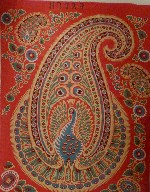Shilasdair Yarns
From Tiny Beginnings ...
By Eva Lambert
Colour was always emotionally important for me, but when living in Turkey for some years, it was the colours of the old textiles which inspired me to experiment with natural dyes. Upon moving to our croft on the Isle of Skye, Tony, my husband, built a large floor loom in our sitting room and I began weaving floor rugs using spindle spinning and weaving techniques learnt in Turkey. Two extended trips to North and West Africa to investigate dyeing techniques fired my enthusiasm for natural dyeing: the weaving stopped and the dyeing became a passion.
But dyeing in the kitchen was not ideal. Grinding cochineal beetles in the blender to dye yarn red was fine. But no matter how carefully I washed the blender, when using it to make mayonnaise for lunch, the mayonnaise would be a deathly skin colour. This worked fine because it inspired Tony to convert an old byre to a dyehouse for me. There I happily dyed one kilo lots, experimenting with the blending of dyestuffs to expand the colour spectrum.
In 1998 Tony converted another old byre into a shop, and Shilasdair was born. Our reputation grew–we were, and still are, the only natural dye company in Scotland–and Tony built a new, larger shop abutting the dye house in 2001, and became a partner. Larger pots were ordered for the dye house and I was now dyeing two kilos at a time, whilst Tony converted an agricultural building to a workplace for hanking, washing, and drying yarns.
| Skeining dyed yarns. | ||
|
|
||
| Photograph Copyright by Robert Feldman |
Each year brought more orders, more enthusiasm and more innovation. Instead of just Aran yarns, we now were buying in Scottish merino, cashmere and silk cord from China and angora from abroad, having these blended for us at Brierly Brothers of Huddersfield. Tony designed labels, with drawings of the dye plants used, for all our yarns, so that customers were able to identify colour by plants. Garments were designed by myself or invited designers and offered either as knitting kits or custom knitted.
Shilasdair was growing year by year. Trade enquiries came in from Japan, the UK, Europe and Canada. But 2 kilos was not enough for shops so another expansion had to take place. We sold the shop (now called the Skye Shilasdair Shop) to a friend, Judi, who has the franchise to sell our products in the Northwest of the Highlands, and took off to India to look at dye cabinets and source quantities of dyestuffs. It was a hectic, but successful, and colourful trip. I was then approached by Quarto Books to write a book on natural dyeing: I wrote about dyeing yarns and Tracy Kendall about dyeing fabrics. The book, The Complete Guide to Natural Dyeing, was published in 2010 by Interweave Press.
Tony has adapted the dye cabinets and the dye recipes so that we can dye using my expanded method and we can now supply in at least 10 kilo lots in a vibrant spectrum of colours and a variety of soft yet durable and easy to knit yarns. Hurrah!
Our 24-colour spectrum is derived from the dyes listed below.
YELLOWS: We use meadowsweet, tansy and ling heather, collected locally. These are the only dye plants which are available on the Isle of Skye. Previously, we used lichens, but they are now protected species.
REDS: Cochineal is the only dye we use that is not from a plant. It came to Europe via the Spaniards in 15th century and is now a cash crop on the Canary Islands. Kermes and Lac also give reds, and are also insect-derived.
BRICK/ORANGE: Our madder from Turkey. In Turkey the water is very hard, which gives a redder tone, but here on Skye our water is extremely soft, hence the more orange tones.
PURPLES: For purple, we use logwood (the central core of the tree) from Central America. Most purples all over the world are derived from wood rather than herbaceous plants.
BLUES: We use indigo from Africa or India. Indigo is a vat dye and is never boiled. The leaves of the indigo plant are fermented, which turns them blue; we get the leaves in powdered form. However, in its blue state, when the indigo is put into the vat of hand-warm water, indogen, the chemical which gives the colour, will not attach to the yarn unless the "indigo blue" is changed to "indigo white" (which is actually canary yellow) and all the oxygen is extracted from the water by adding a combination of caustic soda and sodium dithionite (sodium hydrosulfite). The yarn is dipped into the vat, and when carefully taken out is yellow. It then oxidises and turns quickly from yellow to green to turquoise to blue in seconds, the blue developing for a further half hour or so.
With the above dye stuffs one can mix and blend for an ever expanding spectrum. But as we are now dyeing just for trade, we have developed our own recipes to ensure that our customers have a reasonable consistency. But, with natural dyes there is always that element of variability depending on when the dye stuff was collected, whether it is used dried or fresh, and whether the water is hard or soft. But that's the joy of natural dyeing.
 Turkey Red Journal
Turkey Red Journal
